Croome Court
| Croome Court | |
|---|---|
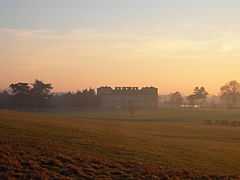 The northern facade of Croome Court and part of its surrounding grounds. | |
| General information | |
| Architectural style | neo-Palladian |
| Town or city | Croome D'Abitot, Worcestershire |
| Country | England |
| Coordinates | 52°06′00″N 2°10′12″W / 52.1000°N 2.1700°W |
| Construction started | 1754 |
| Completed | 1760 |
| Client | George Coventry, 6th Earl of Coventry |
| Design and construction | |
| Architect | Lancelot "Capability" Brown |
Croome Court is a mid 18th century Neo-Palladian mansion surrounded by an extensive landscaped parkland near Pershore in south Worcestershire. The mansion, and park, were designed by Lancelot "Capability" Brown with some of the internal rooms designed by Robert Adam.
The park and garden are owned by the National Trust. The mansion house, Croome Court, was purchased by the Croome Heritage Trust and is currently leased to the National Trust. The Park and Court are both open to the public for most of the year, but the garden is closed during the winter months. It is a pay for entry property, but National Trust members receive free entry.[1][2]
Overview
The house and parkland was Lancelot 'Capability' Brown's first landscape design,[3] and his first major architectural project.[4] and is an important and seminal work.[4] 'Capability' Brown started work at Croome in 1751 for George Coventry, 6th Earl of Coventry. The mansion house was designed by Brown and is a "rare example of his architectural work" and was his "first flight into the realms of architecture".[5] Robert Adam designed parts of Croome Court's interior and along with James Wyatt, designed temples and follies for the park.
House
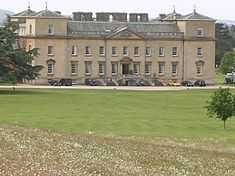
Croome Court was designed by Lancelot "Capability" Brown with the assistance of Sanderson Miller. It was built between 1751 and 1752, and along with Hagley Hall (built between 1754 and 1760), they are considered to be the finest examples of Neo-Palladian architecture in Worcestershire. Notable Neo-Palladian features incorporated into Croome Court include the plain exterior and the corner towers with pyramidal roofs (a feature first used by Inigo Jones in the design of Wilton House in Wiltshire). [6]

The long gallery was designed by Robert Adam and was installed between 1761 and 1766. It is the best preserved of the original interior (little of the rest has survived in situ ).[6]
The house has been visited by George III,[7] Queen Victoria and George V. During the Second World War it housed the Dutch royal family, who were escaping the Nazi occupation of Holland. For part of the war it also housed RAF Defford.[8] In 1948 the Coventry family had to sell the Court.[7] After the war it was used as a school (1950s-1979) and later (1979-84) by Hare Krishnas.[8] It lay empty for 12 years until rescue arrived (though at expense of part of the walled garden being built on for garages) and it was patched up and it became a private home once more with its 17 bedrooms.
One room was removed and is displayed in the Metropolitan Museum of Art in New York: The Tapestry Room "George William, sixth earl of Coventry, commissioned this set of tapestries in Paris in 1763 for the tapestry room at his country seat, Croome Court (Worcestershire), which was then being remodeled by Robert Adam".[9]
In November 2007, Croome Court was bought from the private owner by The Croome Heritage Trust who have leased it to the National Trust for 10 years who will manage it whilst raising funds for its restoration.[7]
The Mansion opened to the public on 26 September 2009, and the National Trust is trying to raise £4.8 million to secure the long-term future of the Court and enter into a 999-year lease from the Croome Heritage Trust.[7] Fundraising activities included a 2011 raffle for a Morgan sports car organised by Lord and Lady Flight.[10]
Walled gardens
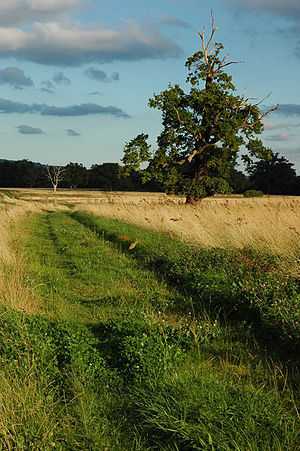
Ann, the wife of the 2nd Earl, was a friend of the poet and avant-garde gardener William Shenstone, and they developed the first garden at Croome. It was around this time that the first kitchen garden was laid out. It would later be encased in walls and possibly by Gilbert, 4th Earl, who is known to have made large changes to both the house and the garden. The earliest plan for a walled garden dates from about 1750, when George William Coventry, the heir of the 5th Earl, changed the shape of the walls from square to the rhomboid shape that exists today. This created a garden of over 7 acres (2.8 ha), which may have made it the largest 18th-century walled garden in Europe. The increase in size allowed the walls to encompass the new greenhouse on the eastern side of the garden. The date that the walls were finished is uncertain, but there is evidence that they must have been completed by 1752.[11]
Over the decades, the shape of the gardens has transformed from a traditional square to the unique rhomboid shape revealing over seven acres of garden which still stand today.
Unlike the grange and the park, the walled garden was largely unchanged by Capability Brown, but it did receive new hot houses. In 1766 a stone-curbed pool for which Robert Adam designed a sundial. In the early 1800s a 13 feet (4.0 m) east/west hot wall, serviced by five furnaces, was built. It is historically significant because it is one of the first ones ever built.[11]
During the 20th century the garden was abandoned, and fell into disrepair.[11] Restoration work on the walled gardens began in 2000; they are gradually being restored.[12] The restoration work revealed a number of hidden gems to the owners, Chris and Karen Cronin...
The Glass Houses: Over the last three centuries the garden has had a number of garden houses, forcing pits and framed structures recorded in Croome's archives. The garden was also featured in Gardening World dating back to 1887, which are still available to this day.
Today, The Walled Gardens showcases the fully restored melon and cucumber house and the peach and fig house, alongside the converted vinery house. The foundations still remain from the original tomato house, forcing beds, pineapple pits, and orchard house all which will be restored in years to come.
After three years of dedicated restoration the melon and cucumber house now channels the rain water from its roof into a large storage tank under the terrace which is then pumped inside through a network of pipes to water an array of produce from vines to bananas, fully supporting the owners' ethos of sustainable and eco-friendly living.
The mechanical inventions of the 18th century have been put to their test in the peach and fig house, with the creation of bespoke steel winding mechanisms to open and close groups of sash and hinging panels, mimicking the old brass rollers now replaced with oil impregnated nylon in stainless steel housings.
The Dipping Pond: Commissioned by the famous Capability Brown and constructed in 1764, The Dipping Pond is one of the gardens most significant features listed in the Croome Archives. It acquired its name from the function of dipping buckets to collect water to distribute around the garden, and for the nearby horse stable block. As a crucially significant element of the gardens history, The Dipping Pond has undergone extensive restoration. It has been completely rebuilt with the addition of a new pressurised water system that has been linked up to a redundant well nearby, creating a pumping station for watering the future vegetable beds within the gardens.
As a by-product of capturing pure rain water, the Dipping Pond has become a new haven for various forms of wildlife, with some rare species of frogs and newts being spotted.
The Hot Wall: A key phase in English garden history between the late 1700s and early 1800s saw the introduction of hot walls and heated cavity walls. This became extinct by 1845 due to the abolishment of a glass tax and emerging technology in hot houses.
The hot wall at The Walled Gardens, constructed in 1806, is the largest of its kind, stretching nearly 100 metres in length and 3 metres in height. Much like the later Glass Houses and forcing beds, the purpose of creating a non-indigenous climate within the gardens, to propagate and extend the growing seasons for fruits and vegetables. The orientation to the wall is sympathetic to the rise and fall of the Sun, not simply east to west, but to maximise heat and light against its southern face.
However, sun was not the sole source for the heat of this wall; during the restoration five underground furnaces were discovered that spread along the northern face of the wall. The furnaces were all backfilled with cobble stones, which now make up the beautifully cobbled garden paths.
The east- and south-facing borders: Both borders have very unique attributes serving very different purposes. The east-facing border boasts 150 m of length and features a curved inline to the northern end of the wall as it adjoins to the Head Gardeners Cottage. This border is significant in many respects because of its orientation to both the Sun and its immediate environment. Currently this border houses an eclectic mixture of hardy shrubs and delicate flowers with Morello cherries, plums and heritage roses fighting for superiority against the wall.
The south-facing border extends from the end of the old Vinery to the north eastern corner of the gardens. Traditionally this wall is mainly used for growing exotic fruits, including peaches, nectarines, apricots and pears. In 2007 it was extended to border out its full depth, unlike the east-facing border a mixture of flowers and vegetables are grown here. Curiously, the leafy plants that grow against the wall, known as Echium, are native to North Africa and are only known to grow on the extreme south-west tip of Cornwall and nowhere else in the UK.
The Woodland: This is the real secret garden ... after discovering this was formerly the estate's dumping ground, significant history has been pieced together from the materials recovered from the woodland. Several archaeological digs have been conducted revealing 200 years' worth of bottles, porcelain, masonry and iron artefacts stacked on top of each other.
For more information visit www.croomewalledgardens.com
Park
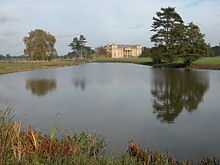

Croome Park has a man made lake and river, statues, temples and other buildings with the Court as the central focus. The other buildings around the park include Gatehouses, a Grotto, a Church and buildings termed "eye-catchers". These are Pirton Tower, Panorama Tower, Dunstall Castle and Park Seat. They are set away from the core of the Park and are intended to draw the eye into the wider landscape. Croome and Hagley Hall have more follies and other similar features than any estate in the England.[13]
The National Trust own and have restored the core of the original 18th century parkland and it is open to visitors throughout the of the year. To visit many of the features below, you have to enter the pay for entry National Trust parkland. Some areas, however, are accessible via public footpaths.
St Mary Magdalene Church: This Grade I listed building was built in 1763 by Capability Brown for the Earl of Coventry. A medieval church nearer the Court was demolished to make way for this church, the interior of which was designed by Robert Adam.
The Rotunda: A domed and circular building close to Croome Court. The building was purchased together with Croome Court by the Croome Heritage Trust in 2007 and the exterior has been restored in 2010 by the National Trust after being left in a state of neglect for decades. It sits on a ridge to the east of Croome Court in the Home Shrubbery and is shrouded in trees, including 200 year old Cedar of Lebanon. Described as a 'garden room',[14] it was designed by Brown and built between 1754-7. The door and windows are pedimented and inside there's a coffered ceiling and stuccowork by Francesco Vassalli in 1761.[14] The Portland stone panels above the windows and door are Robert Adam's design and were carved by Sefferin Alker and added in 1763.[15] The interior has been made stable by the National Trust and work will be continued to restore its interior completely in the future. It is Grade I listed [16] and the National Trust hopes to open the building to the public in the future once restoration is complete.
The Park Seat: Also known as The Owl's Nest. Built in 1770-2 by Adam. It is situated as a lookout over the park.
The London Arch: The main entrance to the house. This once had railings either side.
Temple Greenhouse: This Grade I listed building was also designed by Robert Adam, completed in 1763. It used to have large sash windows in the front of it, now only the grooves where they used to slide can be seen. It housed the Earl's collection of exotic plants and was heated in the winter by a fire lit in a brick bothy at the back, then the heat was channeled underneath through gaps in the floor.
Around the Lake: The grotto and various features were designed by Capability Brown. 50,000 cubic metres of silt and vegetation were removed when restoring the lake. Nearby are the Punch Bowl gates designed by Wyatt in 1793 to 1794. On one of the islands in the lake is the temple pavilion (1776-7).
Island Pavilion: Grade I listed building
London Lodge: Grade I listed building
The Worcester Lodge: A gate house probably built to the designs of Wyatt,[17] in 1801 and subsequently rebuilt in 1879. This sat on the main road to Croome from Worcester. A carriage drive used to run from the lodge directly to the Punch Bowl Gates in the Park itself and onto the Court beyond. The driveway no longer exists and the lodge is now cut off from the rest of the Park by the construction M5 motorway. Today, the lodge is a private residence and not part of the National Trust owned Park. It is a Grade II building.[17] Further down the road on the same side of the M5 is the keeper's house of the menagerie.
Periphery

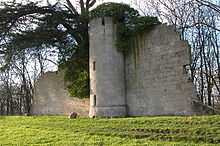

In 2009 after successfully receiving a grant of £284,000 from Natural England,[18] the National Trust acquired and has restored the eye-catchers of the 18th century parkland. They are not at the core of the parkland and they lie close to public footpaths. During 2013 the Panorama Tower and Dunstall Castle were opened for visitors on some days. Check the National Trust web site for days when they will be open during 2014.
The Panorama Tower:. Another domed and circular folly situated on Knight's Hill at the very edge of the park. This is one of the "eye-catchers" designed to draw the eye into the wider landscape and was acquired by the National Trust in 2009 and has been restored by the charity in 2010. The building had been in deterioration for decades. The building was constructed by James Wyatt using design ideas by Robert Adam.[19] It is a circular 2 storey building with a central interior staircase leading up to a viewing platform under a domed roof where there are views across Worcestershire to the Malverns. The building was not completed until after the 6th Earl of Coventry's death, probably in 1812.[19] The Panorama Tower is a prominent feature from the M5 motorway[18] which cuts through the park and the Tower is now separated from the rest of the park and Court, like the Worcester Lodge. It is a Grade I listed building.
Pirton Tower: A sham castle situated on Rabbit Bank which is a prominent ridge in the landscape at Pirton to the north of the park and Court. This is one of the "eye-catchers" designed to draw the eye into the wider landscape which was acquired by the National Trust in 2009 and has been restored by the charity in the same year.[20] The building had been in deterioration for decades and covered in ivy. The building was designed by James Wyatt and built by William Stephens in 1797 as a ruin.[21] The building was constructed among a row of Cedar of Lebanon trees, many of which still stand today along the ridge. It is a Grade I listed building.[22] and Pirton Tower is a feature from the M5 motorway northbound which cuts through the park.
Dunstall Castle: Designed by Robert Adam, this eyecatcher folly,[23] built around 1766, is cut off from the park as it is hidden by trees from within the park. The stones from the tops of the 3 towers have fallen off so that now about a metre is missing from the central tower. The right arch also had a wall at the bottom which has disappeared if compared with original pictures of the castle, however, some restoration has now taken place.
Notes
- ↑ NT staff. "Membership". National Trust.
- ↑ NT staff. "Croome". National Trust.
- ↑ Kay 2008, p. 11.
- ↑ 4.0 4.1 Gordon 2000, p. 2.
- ↑ Stroud 1940, p. .
- ↑ 6.0 6.1 Brooks & Pevsner 2007, p. 56.
- ↑ 7.0 7.1 7.2 7.3 BBC staff 2009, Robert Adam.
- ↑ 8.0 8.1 BBC staff 2008, Croome Court wartime memories.
- ↑ MMA staff 2009, Robert Adam.
- ↑ Williams, David (25 March 2011). "Win a Morgan sports car in raffle organised by a peer". The Daily Telegraph (London).
- ↑ 11.0 11.1 11.2 Tovey 2011, Croome Court garden.
- ↑ FCP staff 2011.
- ↑ Brooks & Pevsner 2007, p. 57.
- ↑ 14.0 14.1 Gordon 2000, p. 117.
- ↑ Garnett 2008, p. 18.
- ↑ Taylor 2009, p. 79.
- ↑ 17.0 17.1 English Heritage staff 2012, Worcester Lodge.
- ↑ 18.0 18.1 Vernalls 2009, Facelift.
- ↑ 19.0 19.1 Gordon 2000, p. 122.
- ↑ MCL staff 2010.
- ↑ Garnett 2008, p. 20.
- ↑ English Heritage staff 2012b, Pirton Tower.
- ↑ Butler 2012, Dunstall Castle.
References
- BBC staff (14 May 2008), Croome Court wartime memories: RAF Defford was a top secret base during WW2, BBC Hereford and Worcester
- BBC staff (25 September 2009), Historic house to open to public, BBC
- Brooks, Alan; Pevsner, Nikolaus (2007), Worcestershire: The buildings of England, Pevsner Architectural Guides (illustrated, revised ed.), Yale University Press, p. 56, ISBN 9780300112986
- Butler, Andrew (2012), Dunstall Castle at Croome Park, Croome D'Abitot, Worcestershire (Image reference 163316), National Trust, retrieved June 2012
- English Heritage staff (2012) [1952], Goodge, Mark, ed., Worcester Lodge and Gates, Croome D'Abitot, British Listed Buildings Online
- English Heritage staff (2012b) [1985], Goodge, Mark, ed., Pirton Tower, Severn Stoke, British Listed Buildings Online
- FCP staff (2011), Croome Court walled / kitchen gardens, Friends of Croome Park: Progress, retrieved June 2012
- Garnett, Oliver (2008), Croome Park - Souvenir Guide, National Trust, pp. 18, 20
- Gordon, Catherine (2000), The Coventrys of Croome, Phillimore & Company, pp. 2, 117, 122
- Kay, Sarah (2008), "Statement of Significance", Croome Court, Paper prepared for the Arts, Architectural & Learning Panels' Visit, National Trust, p. 11
- MCL staff (2010), Pirton Castle, Croome Park, Midland Conservation Ltd, retrieved June 2012
- MMA staff (May 2009) [2000], "Robert Adams: The Croome Court tapestry room, Worcestershire (58.75.1-22).", Heilbrunn Timeline of Art History (New York: The Metropolitan Museum of Art)
- Stroud, Dorothy (6 January 1940), "The Architectural Works of Lancelot Brown", Country Life
- Taylor, Alan (2009), "Malvern Hills" (PDF), in Johnston, Tim, Heritage at Risk Register West Midlands 2009:Register of designated sites at risk in the West Midlands region in 2009. Sites are listed by local planning authority, English Heritage, p. 79
- Tovey, Jill (Archivist for the Croome Estate Trust) (2011), Croome Court walled / kitchen gardens: History, Friends of Croome Park, retrieved June 2012
- Vernalls, Richard (3 May 2009), "Facelift for iconic follies of Croome", Worcester News
External links
| Wikimedia Commons has media related to Croome Park. |